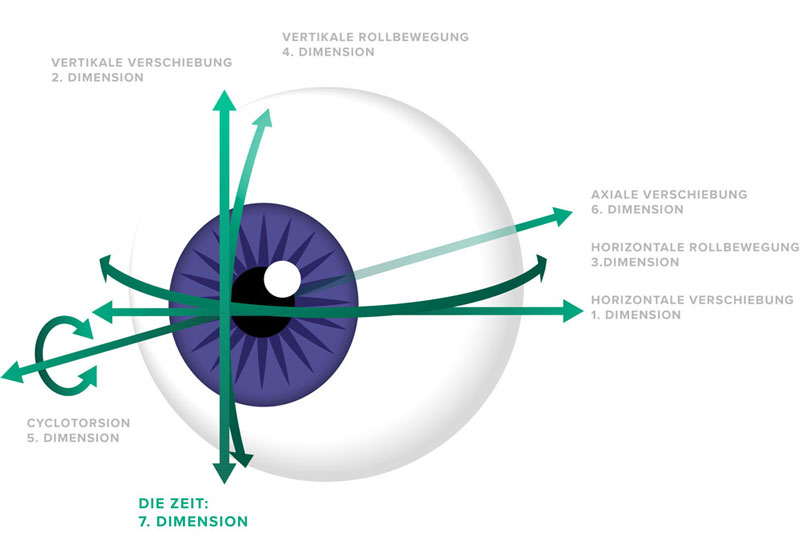Our professional medical team has been treating various visual impairments and age-related vision loss (presbyopia) for more than two decades. Innovative surgical techniques are our speciality. With a focus on laser eye surgery and laser techniques for correcting long and short sightedness, corneal curvature, and presbyopia by means of classic PRK, LASEK, classic LASEK and TransPRK with SmartSurfACE technology, Augenklinik am Marienplatz offers firmly established, highly advanced laser eye treatments. Alternative methods such as the EVO Visian ICL have also become a regular fixture in our portfolio since being launched in the 1990s.
Eye Clinic Marienplatz has for many years been a recognised centre of excellence for ophthalmology in Munich and further afield. We have gained the trust of patients thanks to our gentle yet highly efficient procedures combined with a respectful and mindful approach.
Keeping up with the latest standards in ophthalmology comes as second nature to our entire team. This is how we achieve one our most important goals: patient satisfaction.
Our experienced team at Augenklinik Marienplatz – Dr Tobias Neuhann, Raphael Neuhann and colleagues – looks forward to welcoming you.
Table of Contents

Dr. Niklas Kellermann, FEBO
Eye Surgeon

Raphael Neuhann, FEBO
Eye Surgeon
APPOINTMENT OR MORE INFORMATION?
Initial consultation or appointment bookable online
Mon. – Fri. 8:00 AM – 6:00 PM
Please email us if you have any questions about laser eye surgery at:
[email protected]
Modern ophthalmology covers a wide range of laser eye procedures. Their differences lie mainly in the speed with which the vision is restored after treatment. The methods offer one of the highest levels of safety in human medicine today. For example, the risk of damaging your eyes is higher from regularly wearing contact lenses than from modern methods of surgical correction (refractive surgery).
At the end of the 1980s, classic PRK (photorefractive keratectomy) created the foundation for successful vision correction surgery and so could be described as the “mother of all procedures”. Various modifications and refinements were made to the surgical technique during the 1990s. Even the US military adopted PRK, helping pilots regain their flying licences after successfully undergoing the procedure. Classic PRK has in the meantime become a common procedure and is one of the “superficial methods”. No incision is made in the cornea. Instead, only the outermost layer of cells, the epithelium, is removed. It regenerates itself after treatment. Compared to LASIK, recovery of vision is slower and usually there is slightly more discomfort during the first few days. Following recovery, however, the visual acuity ultimately achieved does not differ from that provided by LASIK or other procedures.
Forget your glasses. Our chosen LASIK procedure is the technique used most worldwide in refractive surgery – provided the cornea is not too thin. Visual impairments of -7 to +3 dioptres can be corrected with such a technique. A thin corneal flap measuring approx. 0.10-0.13 mm is created and folded over either mechanically or with the aid of a femtosecond laser. A second laser (the excimer laser) is then used to correct the visual impairment by modifying the centre of the cornea. Lastly, the small corneal flap is gently replaced, thus additionally accelerating the healing process and visual recovery.
The latest SCHWIND AMARIS excimer laser with SmartSurfACE technology used at our clinic makes a dream come true in TransPRK laser treatment. It is the first treatment of its kind to enable laser vision correction without any contact or incision whatsoever. Short and long sightedness, corneal curvature, more serious visual defects, presbyopia – all these conditions can be treated perfectly without touching your eyes with even the smallest instrument. The laser – i.e. pure light – is aimed precisely at the area of the cornea to be remodelled and gently removes the layer in question. Highly sensitive, lightning-fast tracking systems are used to compensate for tiny eye movements. It sounds incredible – but this is simply a highly advanced form of medicine.
For many eye patients, the very idea of their eye being touched by the surgeon or the chosen laser technique during corrective treatment is extremely unpleasant. There is some reassuring news, however – something every eye patient will surely be glad to hear: The latest SCHWIND AMARIS 1050RS excimer laser with SmartSurfACE technology used at Augentagesklinik Marienplatz has finally brought an end to such concerns in TransPRK laser treatment procedures.
It is the first treatment of its kind for correcting the vision without any contact or incision whatsoever. And, of course, it is totally safe. Sounds incredible, but this is simply a highly advanced form of medicine.
And there’s more good news: SmartSurfACE technology is perfect for treating short and long sightedness, corneal curvature, more severe visual defects, and presbyopia. And all within an extremely short treatment period. Gently, with utmost care and within minutes, your eyesight is fully restored. And afterwards, there will be no further need for aids such as contact lenses or glasses – which is the main reason, after all, for having your vision corrected!
As you will see:
Even sensitive patients need no longer be concerned or fearful about laser treatment. Instead, they can delight in the perfect result from the very beginning. And most importantly, start seeing everything again in the best light.

We will not touch your eyes during the procedure. Instead, we aim the laser precisely at the area of the cornea to be remodelled and then remove the respective layer – carefully, imperceptibly, and painlessly. The treatment itself takes less than a minute! Patients we have treated often ask, “Was that it?” We are always happy to confirm this with a smile.
Even to our very experienced team, the new SCHWIND AMARIS excimer laser is another highlight in the daily treatment of our patients. Dr Neuhann and his team are delighted to be able to offer you the benefits of this technological innovation.
TOUCH-FREE
Using SmartSurfACE technology, laser surgery can be performed on the eyes without physically touching the surface of the cornea. No incision is needed, and long-term this non-invasive treatment offers the highest degree of stability.
STRESS-FREE
Because the treatment is so short, patients feel calm and composed – even more so knowing that the laser correction is easily achieved in a single step.
FAST
The surface of the cornea will have closed again completely after only 3–4 days, and the eyesight will soon be back to its best.
SAFE
The stability of the cornea is preserved completely under the SmartSurfACE technique. Unlike other commonly used methods, treatment is performed directly on the corneal surface. There is hardly any impact on production of the tear film, moreover. Hence, SmartSurfACE is also the ideal solution for patients with dry eyes or contact lens intolerance.
FLEXIBLE
The multifarious nature of visual impairments and the individual demands placed on modern ophthalmology can be very complex. The SCHWIND AMARIS 1050RS platform is also used, therefore, for many different procedures (TransPRK, PRK, LASIK, Femto-LASIK). Given its tremendous flexibility, we can guarantee our patients an individualised treatment plan.
INCREDIBLE
SmartSurfACE technology results in an especially smooth corneal surface. You’ll be enjoying the “wow” effect in no time at all. The extremely short healing process ensures that your eyesight improves much faster than with conventional treatments.
TECHNOLOGY THAT ASTOUNDS
One question our patients frequently ask is, “What happens if I move?” The system recognises the individual structures of your eyes. Movements both big and small are compensated by a 7-dimensional eye tracking system. In technological terms, this method of tracking eye movements is currently as advanced as it can get.

The SCHWIND AMARIS 1050RS combines the latest available technologies in one piece of equipment. With a repetition rate of 1050 Hz and unique 7D eye tracker, it delivers unparalleled speed and safety in laser eye surgery. Whereas a few years ago the idea of “lasering the eyes” was rather unnerving – unnecessarily even back then – in “the eyes” of many patients, the laser has today become an integral part of modern eye medicine. The almost unbelievable precision with which the SCHWIND AMARIS 1050RS can be used to gently treat short and long sightedness, corneal curvature, and other – even more serious – visual impairments was for a long time more a pipe dream than reality. Today, the SCHWIND AMARIS 1050RS guarantees extremely short procedures with a rapid rate of ablation (which is almost imperceptible to the patient) for conditions such as astigmatism. It is gentle on the corneal tissue while smoothing the surface perfectly. How is this achieved? Its unique, ultra-fast eye-tracking system compensates in real time for even the smallest of eye movements and directs each laser pulse with utmost precision to exactly the required spot.
WHAT DOES 1050RS STAND FOR?
The extraordinarily fast repetition rate of the individual laser pulses offers the patient not only greater safety but also comfort. It also shortens the treatment time to just 1.3 seconds per dioptre. Potential dehydration of the cornea is minimised as a result.
FEATURES
IMPORTANCE OF 7D EYE TRACKING
The success of treatment is assured by the active 7D eye tracker, which offers unparalleled precision. The incorporation of diagnostic systems and the ability to thus record all eye movements (both static and dynamic) during the treatment process guarantee the patient outstanding results. During the procedure, the following eye movements are precisely determined and compensated:
Changes in pupil size are detected and automatic adjustments made, as necessary. This automated feature in combination with the 7D eye tracker ensures accurate centring throughout the procedure.
The alternative to laser eye surgery is the implantation of an EVO Visian ICL. If the visual impairment is due not only to poor eyesight but also to a dysfunctional natural lens, refractive lens exchange can also be considered after a certain age. We can advise you during a consultation as to the potential treatments and which would be most appropriate. An appointment for a no-obligation consultation can be booked online.
Since the 1990s, the procedure for correcting impaired vision in the human eye (short sightedness, long sightedness, corneal curvature, presbyopia) using laser eye surgery has continually improved. It is now one of the safest and most widespread elective procedures in human medicine. The conditions for optimal treatment have changed over the decades in certain details, but the treatment as such still follows the same principles. The human cornea, our window to the world, is not only unique due to its clarity but is also the part of the eye that has the greatest influence on refraction of the incoming light. The finest modulations of this refractive index with a laser eye treatment method can have an enormous effect: Your visual impairment will be permanently corrected. The need for glasses and contact lenses is history. The conditions for modern laser eye procedures can be summarised as follows:
We offer no-obligation consultations with either a specially trained, non-medical refractive consultant or a specialised doctor. This preliminary examination will include explanations of the possibilities and limitations of modern refractive surgery depending on your visual impairment and the specific characteristics of your eyes. Aside from objective conditions, your expectations, lifestyle, sports, hobbies, and profession will play a decisive role, along with your general health. This consultation is followed by the main examination. If you wear contact lenses, you will need to go without them for two to four weeks prior to this examination. Your eyes will be checked again at this examination for any “hidden” diseases while also documenting any details relevant to treatment planning. Any final questions on the recovery process, risks, and side effects, can be discussed in detail at this point. A life without glasses is now within reach.

Modern laser eye procedures differ only slightly in how they take place. On arrival at our clinic, you will be welcomed and looked after by our refractive consultants. You will already know them from your previous visits. The procedure will then be explained again, and you will be advised especially about what to do following surgery and the aftercare required. You will be provided with a personal care pack containing goggles and care instructions for the first few hours after treatment. Then you will be given a light sedative to help you relax. We will also prepare your eyes for treatment by applying some anaesthetic eye drops. You will then be escorted to the laser area. From here, you will be guided through each step of the procedure by our experienced surgical team.
Your vision will be foggy and blurred immediately after treatment. Many patients already notice an improvement, however, compared to their eyesight (without glasses) prior to treatment. Nevertheless, it is perfectly normal for your vision to still be poor and even to have a mild sensation of foreign matter or burning in the eye. Your eyes may also water, which is a normal reaction. Once you return home, be sure to follow the treatment plan included in your care pack. After the anaesthetic has worn off, there may be a period of mild discomfort. This will only be mild but in some cases more severe, depending on the patient. It will usually last only a few hours and quickly improves. Moistening the eyes intensively with the eye drops provided and then keeping the eyes closed can help. The eyelids are the best bandage. This will aid in quick recovery of the cornea. It is useful to note the following points:
However safe a treatment may be, there can also be certain risks. These differ somewhat depending on the selected procedure. The risk of eye damage from wearing contact lenses every day is higher, for example, than the probability of complications from laser eye surgery. At Augentagesklinik Marienplatz, the laser procedures we offer meet the very latest technical standards. Eye tracking is one very good example. It enables the laser systems to track your eye movements during treatment so precisely that it is impossible to stray from the target area. The first few hours immediately after treatment are pivotal to recovery.
The eyes will dry out temporarily after undergoing laser treatment. It may feel like there is something in your eye and your visual acuity may fluctuate. This “discomfort” can last a few weeks or months. Tear substitutes containing hyaluronic acid are good in this situation. The severity of these symptoms depends on many factors:
Incidentally, this issue does not arise after implanting a contact lens (ICL), which is why it can be considered a realistic alternative.
Displacement of the very thin corneal disc due to rubbing or scrunching the eyes may necessitate a corrective procedure during the first few days. In rare cases, the superficial corneal cells (epithelial cells) may grow beneath the corneal flap. Such a complication is only detectable after a few weeks and can be rectified by a short intervention. These cells otherwise go unnoticed, and the situation is harmless. Pay careful attention to your doctor’s instructions, however.
Given the automated systems available today and the algorithms that have been enhanced over the decades, fluctuations of 10% to 20% of the target correction only very rarely occur. These fluctuations are attributable to the individual healing process. Residual visual impairment does not mean that treatment has failed, and it can be remedied in a follow-up procedure, if desired, within the first year.
There is an extremely low risk (approx. 1 in 10,000) of infection following laser treatment, which can result in scarring. To avoid this, you will be provided with eye drops to use as a preventive measure before, during and after surgery. Current data also shows that the risk of severe infections is higher from wearing contact lenses than from modern laser surgery techniques.
Not every procedure performed at our eye clinic Marienplatz is equally suitable for all patients. We therefore hold a thorough consultation at the start of treatment to ascertain the circumstances, the chances of success, and the risks of the planned procedure. Many patients have told us that their fear of treatment “especially on the eyes” was the main reason for not seeking advice. Please do share your fears with us, as we can help you overcome them. Our goal is the same as yours: treatment that is both safe and successful. Together, we can find the best solution for clear vision in the future without the need for glasses or contact lenses.

In addition to his training in cataract & refractive surgery, he has worked tirelessly, together with his father, to continually modernise the diagnostic and laser facilities at Eye Clinic Marienplatz. He also specialises in EVO Visian ICL (implantable contact lens) implantation.

Dr. Niklas Kellermann has supported Dr. Neuhann’s team for several years. After completing his specialist training and becoming a Fellow of the European Board of Ophthalmology (FEBO), he has dedicated himself to refractive surgery and, along with Raphael Neuhann, heads the laser eye surgery department at Eye Clinic Marienplatz.
Almost all common visual impairments can be treated today with laser eye surgery. Basic conditions:
Our specially trained non-medical team can gladly provide you with complimentary, no-obligation advice.
The severity of the visual impairment is only one of many variables for determining eligibility, however. We are happy to discuss this with you based on your personal circumstances and can provide you with a suitable treatment proposal. Ask our specially trained non-medical team for advice – without obligation.
Incidentally, other methods are available for correcting more severe visual defects (up to -20 dpt or +10 dpt).
Laser eye surgery usually delivers a lifelong result. In rare cases there may be slight changes over the course of many years. This usually only occurs in patients with initially very severe visual defects.
Each treatment is designed and performed in such a way that, ideally, no subsequent treatment is required. In rare cases, however, the goal may not quite be reached. The residual error can be corrected in a minor follow-up procedure. The same basic conditions apply to follow-up procedures as to initial treatment. Treatment is always limited primarily by the extent of the visual impairment and the thickness of the individual’s corneal tissue. If the latter is too thin, no further laser treatment can be performed. Several laser eye treatments can be performed on healthy eyes, on the other hand.
We will gladly help you choose the right procedure. Your refractive consultant will firstly consider which procedures suit your circumstances and then make a recommendation. If you prefer a particular procedure and it is suitable for your eyes, nothing will stand in the way of treatment.
In most cases, however, your eyes will tell us which procedure is preferable. Our team can determine this and many other aspects as part of a screening examination.
The costs of laser eye surgery vary depending on the procedure. We will discuss the costs of the right procedure with you in our consultation.
Laser eye surgery unfortunately is not a service covered by statutory health insurers, regardless of the severity of the visual impairment.
Private health insurers will pay a contribution, but rarely cover all the costs for laser eye surgery. Reimbursement always depends on your contract and the corresponding terms and conditions. If you are planning to have laser eye surgery, it is best to contact your insurer beforehand. We can gladly provide you with a cost proposal.
This depends on the chosen procedure. Whatever the procedure, your eyesight will already be better on the day after surgery than it was before without glasses. Your vision won’t yet be totally sharp. It usually takes more than the first week for your vision to be fully restored. The peak is usually reached after 4-12 weeks.
Modern laser eye surgery is one of the least painful treatments for the eyes. During the procedure, a local anaesthetic is applied to the eyes to prevent any pain. Depending on the procedure, however, there may be a mild sensation of burning or pressure. The local anaesthetic wears off about 30 minutes to one hour after surgery, and mild pain, burning, itching and eye watering may then occur. We will provide you with an appropriate treatment to get you through any discomfort. The world will already look completely different by the following day!
Yes. As the laser works on the eye for only a few seconds, both eyes can be treated in one session. Only if there is a visual defect in both eyes, of course.
LASIK is the most widespread method of laser eye surgery worldwide. It is one of the safest elective surgical eye treatments available. Wearing contact lenses regularly poses a higher risk of eye damage than laser eye surgery.
After undergoing laser eye surgery, it is important to strictly observe the prescribed eye drop regimen. Special care must be taken to regularly moisten the eyes intensively. Contact sports, swimming, diving etc. should be avoided for at least four weeks (depending on the procedure). Long periods in front of a computer should also be avoided, at least in the first week. Further details can be discussed at your appointment and recommendations relating to the selected procedure can be found in your treatment folder.
Since laser eye surgery is an elective treatment, it is not possible to issue a medical certificate. We recommend planning a week’s holiday. You can use this time to take it easy and enjoy the first few days without your glasses or contact lenses. The more you rest during the first few days, the sooner you will be back to full fitness.

Had cataracts in both eyes, and the first appointment was great. Discussed all my questions about the operation and what lenses would be best for me in detail. Also have no complaints whatsoever about the procedure.
Roland Kammerl
Google Review

One of the best eye surgeons in Europe and the world.
Aksel Icli
Google Review

I’m over the moon that I got the recommendation. Thank you to Dr. Raphael Neuhann and his team. The window on the world I have since surgery gives me a crystal clear view and I can read without glasses again!!! Many many thanks!! I’m overjoyed. I hope this will give lots of patients encouragement.
Helma Kirschner
Google Review
The Munich Eye Clinic at Marienplatz is part of the eye competence center Opthalmologikum Dr. Neuhann. The Eye Clinic Marienplatz is the specialist in Munich for laser eye surgery, refractive surgery and lens operations.
EYE CLINIC MUNICH
OPHTHALMOLOGIKUM DR. NEUHANN
Augentagesklinik Marienplatz
OPENING HOURS
Mo – Thu
FrI
08:00 – 13:00
14:00 – 18:00
08:00 – 13:30